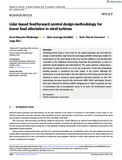Mostrar el registro sencillo del ítem
Lidar-based feedforward control design methodology for tower load alleviation in wind turbines
| dc.creator | Miquélez Madariaga, Irene | es_ES |
| dc.creator | Lizárraga Zubeldia, Idoia | es_ES |
| dc.creator | Díaz de Corcuera Martínez, Asier | es_ES |
| dc.creator | Elso Torralba, Jorge | es_ES |
| dc.date.accessioned | 2022-07-21T12:16:54Z | |
| dc.date.available | 2022-07-21T12:16:54Z | |
| dc.date.issued | 2022 | |
| dc.identifier.citation | Miquelez-Madariaga, I.; Lizarraga-Zubeldia, I.; Diaz de Corcuera, A.; Elso, J.. (2022). Lidar-based feedforward control design methodology for tower load alleviation in wind turbines. Wind Energy. 25,7 1238-1251 . | en |
| dc.identifier.issn | 1095-4244 | |
| dc.identifier.uri | https://hdl.handle.net/2454/43393 | |
| dc.description.abstract | Minimising tower loads is a key issue for the optimal operation and cost-effective design of wind turbines. Light detection and ranging (LIDAR) technologies enable the measurement of free wind ahead of the rotor and the addition of new feedforward controllers to the traditional control loops, improving the performance in terms of generator speed regulation and load reduction. This paper presents a design procedure based on plant inversion at a set of key frequencies. Tower base longitudinal bending moment is considered the main output of the system. Although the minimisation of tower base loads is the main objective of the design, good results are obtained in terms of generator speed regulation and pitch actuation as well. The methodology has been tested in the well-known NREL 5MW wind turbine. Results have been obtained for different LIDAR configurations in order to quantify the loss of performance due to measurement errors. In all cases, the feedforward control behaves better than the baseline case. | en |
| dc.description.sponsorship | The authors gratefully appreciate the support given by Siemens Gamesa Renewable Energy through the predoctoral research contract no. 1055/2020. | en |
| dc.format.mimetype | application/pdf | en |
| dc.language.iso | eng | en |
| dc.publisher | John Wiley & Sons | en |
| dc.relation.ispartof | Wind Energy, 2022, 25 (7),1238-1251 | en |
| dc.rights | © 2022 The Authors. This is an open access article under the terms of theCreative Commons Attribution-NonCommercial-NoDerivsLicense | en |
| dc.rights.uri | http://creativecommons.org/licenses/by-nc-nd/4.0/ | |
| dc.subject | LIDAR | en |
| dc.subject | Load alleviation | en |
| dc.subject | Wind turbine | en |
| dc.title | Lidar-based feedforward control design methodology for tower load alleviation in wind turbines | en |
| dc.type | Artículo / Artikulua | es |
| dc.type | info:eu-repo/semantics/article | en |
| dc.date.updated | 2022-07-20T10:56:22Z | |
| dc.contributor.department | Ingeniería | es_ES |
| dc.contributor.department | Ingeniaritza | eu |
| dc.rights.accessRights | Acceso abierto / Sarbide irekia | es |
| dc.rights.accessRights | info:eu-repo/semantics/openAccess | en |
| dc.identifier.doi | 10.1002/we.2724 | |
| dc.relation.publisherversion | https://doi.org/10.1002/we.2724 | |
| dc.type.version | Versión publicada / Argitaratu den bertsioa | es |
| dc.type.version | info:eu-repo/semantics/publishedVersion | en |



